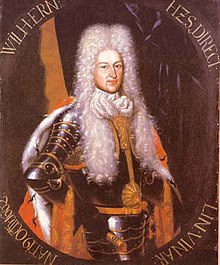Wilhelm Ernst (Saxe-Weimar)
Wilhelm Ernst (* October 19 . Jul / 30 October greg. 1662 in Blankenhain / Holstein; † 26. August 1728 in Weimar ) was Duke of Saxe-Weimar . He came from the Ernestine line of the House of Wettin .
Life
Wilhelm Ernst was born the son of Duke Johann Ernst II and his wife Christina Elisabeth, a born princess of Schleswig-Holstein-Sonderburg . In 1683, after the death of his father, he became reigning duke, but shared the reign with his younger brother Johann Ernst III.

Since his brother was an alcoholic, Wilhelm Ernst managed relatively quickly to put him down politically, so that he himself became de facto sole ruler. Formally, the brother remained co-ruler until his death in 1707, after which Wilhelm Ernst gave his son Ernst August I this role - again without actually giving him a share in power. Wilhelm Ernst married his cousin Charlotte Maria (1669–1703) in 1683 , daughter of Duke Bernhard of Saxony-Jena and his wife Marie de La Trémouille. However, since the marriage remained childless, his nephew Ernst August I became his successor.
In 1691 he founded today's Duchess Anna Amalia Library and a year later he bought Kromsdorf Castle and had it expanded.
Wilhelm Ernst was characterized by strict Lutheranism and bigoted piety. At his court, bed rest was ordered at eight o'clock in winter and nine in summer, he ordered his soldiers to attend church services and then had them recount the content of the sermon. However, Wilhelm Ernst became known especially through his dealings with Johann Sebastian Bach . The composer worked as court organist and concert master in Weimar from 1708. When Duke Bach overlooked the position of court conductor, he asked him to be released from the state service. Annoyed by the musician's rebelliousness, Wilhelm Ernst had Bach imprisoned for four weeks before he was expelled from the country. This process led to Wilhelm Ernst receiving a place in all Bach biographies as an authoritarian art bogeyman .
During the reign of Wilhelm Ernst, the duchy he ruled expanded, since in 1690 the Ernestine branch line Saxony-Jena died out. Saxony-Jena was then divided between Saxony-Weimar and Saxony-Eisenach and Wilhelm Ernst inherited parts of the neighboring duchy.
His coffin is in the Princely Crypt of the Weimar Historical Cemetery .
literature
- Gustav Lämmerhirt: Wilhelm Ernst . In: Allgemeine Deutsche Biographie (ADB). Volume 43, Duncker & Humblot, Leipzig 1898, pp. 195-201.
Web links
| predecessor | Office | successor |
|---|---|---|
| Johann Ernst II. |
Duke of Saxe-Weimar 1683 - 1728 |
Ernst August I. |
| personal data | |
|---|---|
| SURNAME | Wilhelm Ernst |
| BRIEF DESCRIPTION | Duke of Saxe-Weimar |
| DATE OF BIRTH | October 30, 1662 |
| PLACE OF BIRTH | Blankenhain , Holstein |
| DATE OF DEATH | August 26, 1728 |
| Place of death | Weimar |

